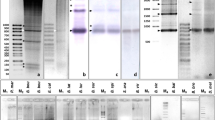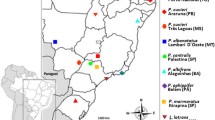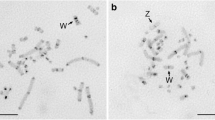Abstract
Two highly abundant satellite DNAs comprise 36% of the Tenebrio obscurus (Tenebrionidae, Coleoptera) genome. They are designated as satellite I and satellite II with the monomer length of 344 and 142 base pairs (bp), respectively. Both satellites differ in their nucleotide (nt) sequences, but the frequency of point mutations, well-conserved length of monomer variants, stretches of shared mutations characteristic for the process of gene conversion, and distribution of both satellites in regions of centromeric heterochromatin of all chromosomes indicate that the same evolutionary processes act on both of them with the same, or similar, rate. While satellite I shares no sequence similarity with any other known nt sequence, satellite II is 79.7% homologous with the highly abundant satellite from closely related Tenebrio molitor. Difference in the frequency of point mutations and absence of shared mutations indicating gene conversion strongly suggest that in these two closely related species mutational processes affecting satellite DNAs seem to be changed. Retarded electrophoretic mobility, due to sequence-induced curvature of DNA helix axis, was observed for T. obscurus satellite II, but not for satellite I. Although evolutionary processes act with different rates in T. obscurus and T. molitor satellites the monomer length and sequence-induced curvature are well preserved in both 142-bp satellites, as well as in, at the nt sequence level completely divergent, Palorus ratzeburgii (Tenebrionidae) satellite, indicating potential importance of these parameters in their evolution.
Similar content being viewed by others
References
Abad JP, Carmena M, Baars S, Saunders RDC, Glover DM, Ludena P, Sentis C, Tyler-Smith C, Villasante A (1992) Dodecasatellite: a conserved G + C rich satellite from the centromeric heterochromatin of Drosophila melanogaster. Proc Natl Acad Sci U S A 89:4663–4667
Arnason U, Hoglund M, Widegren B (1984) Conservation of highly repetitive DNA in cetaceans. Chromosoma 89:238–242
Arnason U, Best PB (1991) Phylogenetic relationships within the Mysticeti (whalebone whales) based upon studies of highly repetitive DNA in all extant species. Hereditas 114:263–269
Bachmann L, Sperlich D (1993) Gradual evolution of a specific satellite DNA family in Drosophila ambigua, D. tristis and D. obscura. Mol Biol Evol 10:647–659
Benson D, Lipman DJ, Ostell J (1993) Genbank. Nucleic Acids Res 21:2963–2965
Bogenberger JM, Neitzel H, Fittler F (1987) A highly repetitive DNA component common to all Cervidae: its organization and chromosomal distribution during evolution. Chromosoma 95:154–161
Davis CA, Wyatt GR (1989) Distribution and sequence homogeneity of an abundant satellite DNA in the beetle, Tenebrio molitor. Nucleic Acids Res 17:5579–5586
Dod B, Mottez E, Desmarais E, Bonhomme F, Roizes G (1989) Concerted evolution of light satellite DNA in genus Mus implies amplification and homogenization of large blocks of repeats. Mol Biol Evol 6:478–491
Dover GA (1982) Molecular drive: a cohesive model of species evolution. Nature 299:111–117
Dover GA (1986) Molecular drive in multigene families: how biological novelties arise, spread and are assimilated. Trends Genet 168:159–165
Drouin G, Dover GA (1990) Independent gene evolution in the potato actin gene family demonstrated by phylogenetic procedures for resolving gene conversions and the phylogeny of angiosperm actin genes. J Mol Evol 31:132–150
Hsieh T, Brutlag D (1979) Sequence and sequence variation within the 1.688 g/cm3 satellite DNA of Drosophila melanogaster. J Mol Biol 135:465–481
Juan C, Gosalvez J, Petitpierre E (1990) Improving beetle karyotype analysis: restriction endonuclease banding of Tenebrio molitor chromosomes. Heredity 65:157–162
Juan C, Gosalvez J, Mezzanotte R, Petitpierre E (1991) Cytological and biochemical characterization of the in situ endonuclease digestion of fixed Tenebrio molitor chromosomes. Chromosoma 100:432–438
Juan C, Vazquez P, Rubio JM, Petitpierre E, Hewitt GM (1993) Presence of highly repetitive sequences in Tribolium flour-beetles. Heredity 70:1–8
Kumar A, Rai KS (1992) Conservation of a highly repeated DNA family of Aedes albopictus among mosquito genomes (Diptera: Culicidae). Theor Appl Genet 83:557–564
Laursen HB, Jorgensen AL, Jones C, Bak AL (1992) Higher rate of evolution of X chromosome alpha repeat DNA in human than in the great apes. EMBO J 11:2367–2372
Lobe A, Roberts P (1988) Evolution of satellite DNA sequences in Drosophila. In: Verma RS (ed) Heterochromatin. Cambridge University Press, Cambridge, England, pp 148–186
Martinez-Balbas A, Rodriguez-Campos A, Garcia-Ramirez M, Sainz J, Carrera P, Aymami J, Azorin F (1990) Satellite DNAs contain sequences that induce curvature. Biochemistry 29:2342–2348
Miklos GLG (1985) Localized highly repetitive DNA sequences in vertebrate and invertebrate genomes. In: MacIntyre RJ (ed) Molecular evolutionary genetics. Plenum Press, New York, pp 241–321
Pages MJ, Roizes GP (1984) Nature and organization of the sequence variations in the long-range periodicity calf satellite DNA I. J Mol Biol 173:143–157
Petitpierre E, Gatewood JM, Schmid CW (1988) Satellite DNA from the beetle Tenebrio molitor. Experientia 44:498–499
Pinkel D, Gray J, Trask B, van den Engh G, Fuscoe J, van Dekken H (1986) Cytogenetic analysis by in situ hybridization with fluorescently labeled nucleic acids probes. Cold Spring Harbor Symp Quant Biol 51:151–157
Plohl M, Borštnik B, Ugarković Đ, Gamulin V (1990) Sequence-induced curvature of Tenebrio molitor satellite DNA. Biochimie 72:665–670
Plohl M, Borštnik B, Lucijanić-Justić V, Ugarković Đ (1992) Evidence for random distribution of sequence variants in Tenebrio molitor satellite DNA. Genet Res 60:7–13
Plohl M, Lucijanić-Justić V, Ugarković D, Petitpierre E, Juan C (1993) Satellite DNA and heterochromatin of the flour beetle Tribolium confusum. Genome 36:467–475
Plohl M, Ugarković Đ (1994) Analysis of divergence of Alphitobius diaperinus satellite DNA—roles of recombination, replication slippage and gene conversion. Mol Gen Genet 242:297–304
Radić MZ, Lundgren K, Hamkalo BA (1987) Curvature of mouse satellite DNA and condensation of heterochromatin. Cell 50:1101–1108
Rojas-Rousse D, Bigot Y, Periquet G (1993) DNA insertions as a component of the evolution of unique satellite DNA families in two genera of parasitoid wasps: Diadromus and Eupelmus (Hymenoptera). Mol Biol Evol 10:383–396
Sainz J, Cornudella L (1990) Preservation of a complex satellite DNA in two species of Echinoderms. Nucleic Acids Res 18:885–890
Sambrook J, Fritsch EF, Maniatis T (1989) Molecular cloning. A laboratory manual. Cold Spring Harbour Laboratory, Cold Spring Harbour, pp 9.16–9.19
Sanger F, Nicklen S, Coulson AR (1977) DNA sequencing with chain-terminating inhibitors. Proc Natl Acad Sci U S A 74:5463–5476
Strachan T, Webb D, Dover GA (1985) Transition stages of molecular drive in multiple-copy DNA families in Drosophila. EMBO J 4:1701–1708
Tares S, Cornuet JM, Abad P (1993) Characterization of an unusually conserved Alul highly reiterated DNA sequence family from the honeybee, Apis mellifera. Genetics 134:1195–1204
Trick M, Dover GA (1984) Unexpectedly slow homogenisation within a repetitive DNA family shared between two subspecies of tsetse fly. J Mol Evol 20:322–329
Ugarković Đ, Plohl M, Gamulin V (1989) Sequence variability of satellite DNA from the mealworm Tenebrio molitor. Gene 83:181–183
Ugarković Đ, Plohl M, Lucijanić-Justić V, Borštnik B (1992) Detection of satellite DNA in Palorus ratzeburgii: analysis of curvature profiles and comparison with Tenebrio molitor satellite DNA. Biochimie 74:1075–1082
Ugarković Đ, Plohl M, Petitpierre E, Lucijanić-Justić V, Juan C (1994) Tenebrio obscurus satellite DNA is resistant to cleavage by restriction endonucleases in situ. Chromosome Res 2:217–223
Author information
Authors and Affiliations
Additional information
Correspondence to: Đ. Ugarković
Rights and permissions
About this article
Cite this article
Plohl, M., Ugarković, Đ. Characterization of two abundant satellite DNAs from the mealworm Tenebrio obscurus . J Mol Evol 39, 489–495 (1994). https://doi.org/10.1007/BF00173418
Received:
Accepted:
Issue Date:
DOI: https://doi.org/10.1007/BF00173418




